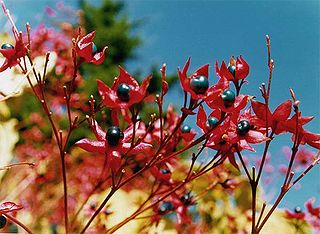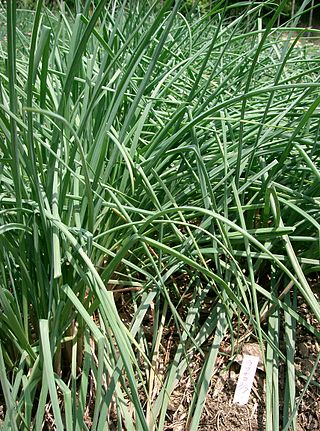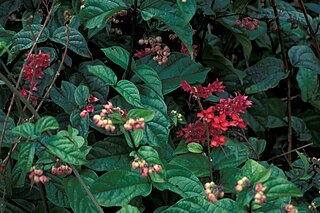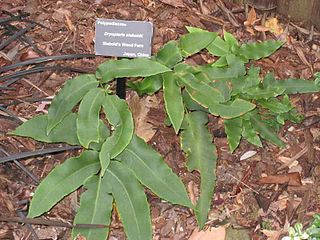
Philadelphus (mock-orange) is a genus of about 60 species of shrubs from 3–20 ft tall, native to North America, Central America, Asia and (locally) in southeast Europe.

Liriodendron chinense is Asia's native species in the genus Liriodendron. This native of central and southern China grows in the provinces of Anhui, Guangxi, Jiangsu, Fujian, Guizhou, Hubei, Hunan, Jiangxi, Shaanxi, Zhejiang, Sichuan and Yunnan, and also locally in northern Vietnam. Protected populations occur in the Tianmushan National Reserve, Huangshan, Wuyi Shan, and Badagongshan Nature Reserve.

Volkameria is a genus of flowering plants in the family Lamiaceae. It is pantropical in distribution. Many of the species are found in coastal habitats.

Clerodendrum thomsoniae is a species of flowering plant in the genus Clerodendrum of the family Lamiaceae, native to tropical west Africa from Cameroon west to Senegal. It is an evergreen liana growing to 4 m (13 ft) tall, with ovate to oblong leaves 8–17 cm (3–7 in) cm long. The flowers are produced in cymes of 8–20 together, each flower with a pure white to pale purple five-lobed calyx 2.5 cm in diameter, and a red five-lobed corolla 2 cm long and in diameter. The flowers are born in cymose inflorescences arising from the axils of the leaves. The leaves, in turn, are arranged opposite to each other and at right angles to the pairs above and below.

Clerodendrum is a genus of flowering plants formerly placed in the family Verbenaceae, but now considered to belong to the Lamiaceae (mint) family. Its common names include glorybower, bagflower and bleeding-heart. It is currently classified in the subfamily Ajugoideae, being one of several genera transferred from Verbenaceae to Lamiaceae in the 1990s, based on phylogenetic analysis of morphological and molecular data.

Allium chinense is an edible species of Allium, native to China, and cultivated in many other countries. Its close relatives include the onion, scallion, leek, chive, and garlic.

A rose garden or rosarium is a garden or park, often open to the public, used to present and grow various types of garden roses, and sometimes rose species. Designs vary tremendously and roses may be displayed alongside other plants or grouped by individual variety, colour or class in rose beds. Technically it is a specialized type of shrub garden, but normally treated as a type of flower garden, if only because its origins in Europe go back to at least the Middle Ages in Europe, when roses were effectively the largest and most popular flowers, already existing in numerous garden cultivars.

Charles Maries was an English botanist and plant collector who was sent by James Veitch & Sons of Chelsea, London to search for new hardy plants in Japan, China and Taiwan between 1877 and 1879; there he discovered over 500 new species, which Veitch introduced to England. Amongst his finds, several bear his name, including Abies mariesii, Davallia mariesii, Hydrangea macrophylla "Mariesii", Platycodon grandiflorus "Mariesii" and Viburnum plicatum "Mariesii".

Eriocapitella hupehensis, a species of flowering plant in the buttercup family Ranunculaceae, is native to Asia. The specific epithet hupehensis, which means "from Hupeh province, China", refers to a region where the species is known to occur. In Chinese, it is called dǎ pò wǎn huā huā (打破碗花花), which means "broken bowl flower".
Phyllocharis undulata is a species of leaf beetle, native to Southeast Asia. It is found in Laos, Cambodia, Vietnam, Peninsular Malaysia, Singapore, Java, Lombok and Timor.

Clerodendrum splendens, the glory tree or flaming glorybower, is a species of flowering plant in the genus Clerodendrum of the family Lamiaceae, native to tropical Western Africa. It is a twining evergreen climber, growing to 3 metres (9.8 ft) or more, with panicles of brilliant scarlet flowers in summer. With a minimum temperature of 10 °C (50 °F), it requires the protection of glass during the winter months in most temperate regions.

Abelia chinensis, commonly known as Chinese abelia, is a species of flowering plant in the honeysuckle family Caprifoliaceae. It is a semi-evergreen, densely branched shrub with dark green foliage.

Pteris cretica, the Cretan brake, ribbon fern, or Cretan brake fern, is a species of evergreen fern in the family Pteridaceae, native to Europe, Asia and Africa.

Clerodendrum bungei, commonly known as rose glory bower, glory flower or Mexican hydrangea, is a species of flowering plant in the deadnettle family, Lamiaceae. Native to China, it is commonly grown in gardens as an ornamental shrub. It has escaped from cultivation and is naturalized in the Americas.

Euonymus carnosus, called the fleshy‑flowered spindletree, is a species of flowering plant in the genus Euonymus, native to southeast and south‑central China, Taiwan, the Bonin Islands, the Ryukyu Islands, and Japan. It has gained the Royal Horticultural Society's Award of Garden Merit.

Epimedium acuminatum, called the acuminate barrenwort, is a species of flowering plant in the genus Epimedium, native to south-central and southeast China. It has gained the Royal Horticultural Society's Award of Garden Merit.

Euphorbia sikkimensis, called the Sikkim spurge, is a species of flowering plant in the genus Euphorbia, native to Nepal, the eastern Himalayas, Tibet, south-central and southeast China, Myanmar, and Vietnam. It grows in alpine meadows, sparse forests, and scrub. It has gained the Royal Horticultural Society's Award of Garden Merit.

Dryopteris sieboldii is a species of fern in the family Dryopteridaceae, native to Japan and south-central and southeast China. It has gained the Royal Horticultural Society's Award of Garden Merit as an ornamental.

Deutzia setchuenensis, the Sichuan deutzia, is a species of flowering plant in the family Hydrangeaceae, native to southeast and south-central China. The variety Deutzia setchuenensis var. corymbiflora, called the corymbose deutzia or Chinese snow flower, has gained the Royal Horticultural Society's Award of Garden Merit. Growing to 2.5 m (8.2 ft) tall by 1.5 m (4.9 ft) broad, it is a deciduous shrub with flat panicles of small white flowers in early summer. It prefers full or partial sunlight, in moist fertile soil.

Pleioblastus fortunei is a species of bamboo in the family Poaceae. It is native to central and southern Japan, and has been introduced to southeast China, the North and South Islands of New Zealand, Maryland, Virginia, and the District of Columbia in the United States, Columbia, South East Brazil and India. It is hardy to −10 °F (−23 °C); USDA Hardiness zone 6a. It is an invasive species, escaping from cultivation and difficult to control, even surviving mowing. As its synonym Pleioblastus variegatus, dwarf white-striped bamboo, a variegated morph, has gained the Royal Horticultural Society's Award of Garden Merit.




















